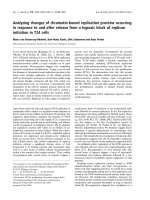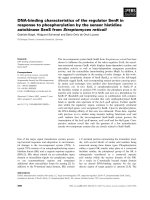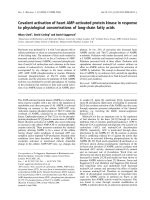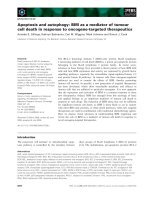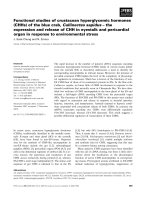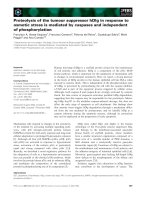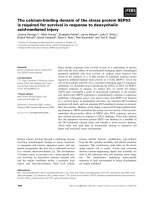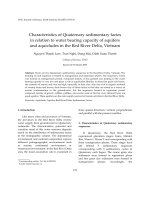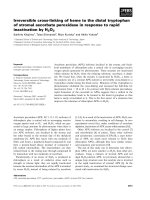PURIFICATION OF SIMPL ANTIBODY AND IMMUNOFLUORESCENCE OF SIMPL SUB-CELLULAR LOCALIZATION IN RESPONSE TO TNFα- AND IL-1
Bạn đang xem bản rút gọn của tài liệu. Xem và tải ngay bản đầy đủ của tài liệu tại đây (1.35 MB, 63 trang )
PURIFICATION OF SIMPL ANTIBODY AND IMMUNOFLUORESCENCE OF
SIMPL SUB-CELLULAR LOCALIZATION IN RESPONSE TO TNFα- AND IL-1
Steven B. Cogill
Submitted to the faculty of the University Graduate School
in partial fulfillment of the requirements
for the degree
Master of Science
in the Department of Biochemistry and Molecular Biology,
Indiana University
January 2011
ii
Accepted by the Faculty of Indiana University, in partial
fulfillment of the requirements for the degree of Master of Science.
___________________________________
Maureen A. Harrington PhD, Chair
___________________________________
Mark G. Goebl, PhD
Master’s Thesis
Committee
___________________________________
Sonal P. Sanghani PhD
iii
Acknowledgements
I would like to thank my thesis advisor, Dr. Maureen Harrington, for her support in
my pursuit of a Master’s degree. I would also like to thank my committee members, Dr.
Mark Goebl and Dr. Sonal Sanghani for their input and suggestions. I am also grateful to
the members of Dr. Goebl’s lab, Dr. Josh Heyen and Dr. Ross Cocklin, for the help that
they provided. I am also greatly appreciative of Dr. Clark Wells and the members of his
lab for providing reagents as well as assisting with confocal microscopy experimentation.
I would also like to thank Dr. Milli Georgiadis for providing reagents. In final, I would
like to thank the Biochemistry and Molecular Biology Department at Indiana University.
iv
Abstract
Steven B. Cogill
PURIFICATION OF SIMPL ANTIBODY AND IMMUNOFLUORESCENCE OF
SIMPL SUB-CELLULAR LOCALIZATION IN RESPONSE TO TNF-α AND IL-1
SIMPL is a transcriptional co-activator that alters the activity of transcription factor,
NF-κB. In response to pathogens, cytokines such as Interleukin-1 (IL-1) and Tumor
Necrosis Factor (TNF) signal through the IL-1 and TNF-α receptors, respectively, which
are found on various cell types. Activation of these receptors can result in the nuclear
localization of NF-κB where it enables the transcription of several different genes key in
the innate immune response. Endogenous co-localization of the SIMPL protein with NF-
κB in response to these same cytokine signals has yet to be demonstrated. Polyclonal
antibody generated against a truncated version of the SIMPL protein was purified from
the sera obtained from immunized rabbits using affinity chromatography. The antibody
was found to have a high specificity for both the native and denatured form of the protein
as demonstrated by the lack of nonspecific bands observed in immunoprecipitations and
Western blotting. The antibody was utilized in immunofluorescence experiments on
mouse endothelial cells that were either unstimulated or were stimulated (IL-1 or TNF-α).
In the absence of cytokine, SIMPL was localized in both the cytoplasm and the nucleus
as opposed to NF-κB which was almost exclusively localized in the cytoplasm. In the
presence of IL-1, the concentration of SIMPL in the nucleus was increased, and in the
presence of TNF-α, the concentration of SIMPL in the nucleus was even greater. Results
of this study identified future routes for SIMPL antibody isolation as well as to
v
demonstrate that endogenous SIMPL protein nuclear localization may not be solely
dependent upon TNF-α signaling.
Maureen A. Harrington PhD, Chair
vi
Table of Contents
Introduction 1
A. The immune response 1
B. Inflammation 2
C. Production of knockout mice through gene trapping 3
D. Antibodies 4
1. Applications 5
2. Production 6
3. Purification 6
E. Elucidating the role of SIMPL protein 7
1. NF-κB activation 7
2. The importance of mPLK/IRAK-1 8
3. The discovery of SIMPL 8
Methods and Materials 10
A. Wild type and SIMPL knockout mice 10
B. Cell lines 10
C. Reagents 10
D. Antibody purification 10
1. Dialysis 11
2. Stringent column wash 11
E. Protein quantification 11
1. Bradford assay 11
2. UV Absorbance 12
F. SDS-PAGE and Coomassie blue staining 12
G. Western blotting 12
H. Immunoprecipitation 13
I. Immunofluorescence 14
Results 15
A. Purification of SIMPL antibody from 086 and 087 rabbit sera 15
1. Recombinant SIMPL protein is effectively bound to the column material 15
vii
2. Dialysis of purified SIMPL antibody causes the formation of precipitate 15
3. Affinity column eluant contains antibody 16
B. Western blotting using purified antibody 16
1. 087F antibody is capable of detecting low concentrations of purified
SIMPL 16
2. Immunoprecipitation reactions show SIMPL contamination of the 087F
antibody 17
C. Stringent washing of the Amino-Link column 17
1. High concentrations of guanidinium are effective in removing excess
protein from the affinity column 17
2. Stringent wash and aliquot analysis allow for isolation of uncontaminated
antibody 18
D. Validation of the 087J antibody 19
1. 087J antibody binds native SIMPL protein 19
2. 087J antibody detects SIMPL protein and a splice variant in testes tissue
blot. 20
E. Immunofluorescence 20
1. SIMPL protein exhibits passive nuclear localization and is concentrated by
NF-κB subunit p65 in the nucleus of endothelial cells 20
Discussion 22
A. ∆23SIMPL’s effectiveness in the purification of SIMPL antibody 22
B. The effectiveness of washing an AminoLink column with various solvents 23
C. The differential elution of bound and unbound SIMPL antibody 23
D. Uncontaminated antibody allowed for the detection of SIMPL 24
E. SIMPL concentrates in the nucleus of endothelial cells in response to TNFα
and IL-1 25
F. Possible degradation of the 087J antibody 26
G. Future directions of study with a functional SIMPL antibody 27
References 45
Curriculum Vitae
viii
List of Tables
Table 1. Flow chart that outlines the various antibody purification attempts 38
ix
List of Figures
Figure 1. NF-κB activation 28
Figure 2. Cytokine activation of NF-κB in the presence of catalytically inactive
IRAK-1 29
Figure 3. Proposed model of SIMPL activation and interaction with NF-κB 300
Figure 4. Elution profiles for the purifications of SIMPL antibody 311
Figure 5. PAGE gel containing isolated protein stained with coomassie blue 322
Figure 6. Western blot of known quantities of purified ∆23 SIMPL with the 087F
purification acting as the primary antibody 333
Figure 7. Immunoprecipitation of tissue lysates from SIMPL KO and WT mice 344
Figure 8. Western blot of the affinity purified 087F antibody 355
Figure 9. The protein content in aliquots of the column fractions during the stringent
washing of the SIMPL affinity column 366
Figure 10. Western blot of column aliquots from the 087J purification 377
Figure 11. Immunoprecipitation of the WT and SIMPL KO testes tissue lysate 39
Figure 12. A repeat of the experiment shown in Figure 9 that was performed 1 week
later 40
Figure 13. Western blot of WT and SIMPL KO testes tissue lysate 41
Figure 14. Immunostaining of the p65 subunit in NF-κB for human endothelial cells 42
Figure 15. Immunostaining of the SIMPL protein for human endothelial cells 43
Figure 16. The color combined images from Figure 13 with corresponding MIP’s
from selected sections of the image captures 44
x
List of Abbreviations
BSA Bovine serum albumin
BME β-mercaptoethanol
CAK1 Cyclin dependent protein kinase-activating kinase
dd double distilled
DAPI 4’,6-diamidino-2-phenylindole, dihydrochloride
ELISA enzyme-linked immunosorbent assay
ES embryonic stem
EST expressed sequence tag
HEPES 4-(2-hydroxyethyl)piperazine-1-ethanesulfonic acid
Ig immunoglobulin
IL-1 Interleukin-1
IRAK-1 Interleukin-1 receptor associated kinase
KO knock-out
LPS Lipopolysaccharide
MEF Mouse embryonic fibroblast
MIP maximum-intensity projection
mPLK mouse pelle-like kinase
NF-κB Nuclear Factor-κB
PAMPs pathogen-associated molecular patterns
PAGE poly-acrylamide gel electrophoresis
PVDF polyvinylidene fluoride
PBS phosphate buffered saline
PBST phosphate buffered saline with Tween 20
PCR polymerase chain reaction
RT-PCR reverse transcription-polymerase chain reaction
RHD Rel Homology Domain
Risc RNA-induced silencing complex
SIMPL signaling molecule that interacts with mouse pelle-
like kinase
xi
TIGM Texas Institute for Genomic Medicine
Tlr 4 Toll-like receptor 4
TNFα Tumor Necrosis Factor α
TNF-R1 Tumor Necrosis Factor Receptor-1
UV ultraviolet
WT Wild type
1
INTRODUCTION
The goal of my thesis was to further the study of a transcriptional co-activator of the
nuclear factor that binds the enhancer of the κ chain (NF-κB). This molecule is called
signaling molecule that interacts with mouse pelle-like kinase (SIMPL). This introduction
will act to give a broad overview of the immune response and inflammation to illustrate
the importance of NF-κB and the far reaching effects of its regulation. Also the
introduction will focus on some of the biotechnological aspects of the project, including
knockout mouse production through the use of gene trap vectors as well as the
purification and production of antibodies and their applications. The introduction is
concluded by describing the work that has previously been done by the Harrington lab on
SIMPL and its interacting protein, interleukin-1 receptor associated kinase (IRAK-1).
A. The immune response
The immune system is an organism’s defense against foreign elements such as
pathogens or other possibly harmful agents. There are two arms of this system, the innate
and adaptive, which must operate in a coordinated fashion to mount an appropriate
response. The innate immune system is an evolutionarily conserved system that acts in a
non-specific manner towards pathogenic insults. The innate response acts to initiate
inflammation, recruit other innate immune cells to the site of infection, and mobilize the
adaptive response. It is activated through the recognition of the general signatures of
pathogenic agents known as pathogen-associated molecular patterns (PAMPs)
(Medzhitov and Janeway 2002). Innate response cells such as macrophages are localized
throughout tissues and organs. The macrophage cells which are distinct to their respective
tissues or organs can act as the initial detectors of pathogenic insults through receptors
which are constant from cell to cell within a tissue (Glaros et al. 2009; Gordon 2007).
PAMP receptors can include the family of toll-like receptors; for example toll-like
receptor 4 (Tlr4) recognizes lipopolysaccharides (LPS) found in the cell wall of gram
negative bacteria. The LPS binds to Tlr4 and can activate transcription factors including
NF-κB which in turn up regulates the transcription of pro-inflammatory cytokines such as
tumor necrosis factor α (TNFα) (Beutler et al. 1985; Du et al. 1999; Li et al. 2002). These
pro-inflammatory cytokines are secreted by the macrophages, and act to initiate the
2
inflammatory response. The adaptive immune cells or lymphocytes act as secondary
responders which are targeted towards specific antigens. The adaptive arm of the immune
system also has the capability to mount a memory response which is more rapid and
greater in magnitude than the native adaptive response as well as the innate response.
Another species of local innate immune cells, the dendritic cells, are one of the first
coordinating links between the innate and adaptive response. These cells when activated
become antigen presenting cells that transport antigens to the lymph tissues that house the
lymphocytes (B and T cells) (Austyn et al. 1983; Qi et al. 2006). Naive helper T cells are
activated by antigens binding to T cell receptors specific to the antigen, and this causes a
clonal expansion of T cells which contain the targeted receptor. These cells in turn
differentiate into cytotoxic T cells as well as memory T cells. The helper T cells remain
in the lymph tissue where they secrete cytokines and chemokines to manage the activity
of B cells, cytotoxic T cells, and macrophages (Hommel 2004; Andersen et al. 2006;
Bonilla and Oettgen 2010) The B cells which also undergo receptor specific clonal
expansion upon exposure to antigens secrete antibodies that target antigens which allows
for degradation by natural killer cells. The antibodies also work with the complement
system to target pathogens. Other roles of antibodies include blocking key receptors due
to binding as well as segregation of possibly key proteins both of which may hinder
pathogen survival (Carroll 2008; Zola 1985). Activation of NF-κB through T cell
receptors and B cell receptors plays a key role in lymphocyte maturation, survival,
activation, and clonal expansion (Gerondakis and Siebenlist 2010).
B. Inflammation
Acute inflammation arises in tissues and organs in response to threats to the organism
such as pathogenic invasion or tissue damage. The inflammation response is the
remodeling of the microenvironment at the site of the specific insult to allow for the
effective removal of the threat in question and a return to homeostasis for the organism.
The effects of inflammation were observed on a macroscopic scale centuries ago which
led to the common indicators of inflammation, redness, swelling, pain, and heat (Libby
2007). These symptoms arise from changes in the blood vessels at the site of infection to
allow for the influx of immune cells. Alterations to the vessels include clotting, secretion
of proteins to adhere circulating immune cells to the vessel wall, and development of
3
looser junctions between adjacent cells for greater permeability (Nathan 2002). These
changes are initiated by the secretion of the pro-inflammatory cytokines TNFα and
interleukin-1 (IL-1) by the local macrophages which act on endothelial cells (Goerdt et al.
1987; Schorer et al. 1986). Activation of NF-κB through cytokine receptors is essential to
the inflammatory response. For example tissue factor, a protein secreted by the
endothelial cells to aid in the clotting process is transcriptionally controlled by NF-κB
(Bierhaus et al. 1995; Zhang et al. 1999). Pro-inflammatory signaling acts to remove any
pathogens present, and upon its removal, the response initiates tissue repair through
production of anti-inflammatory molecules (Nathan 2002).
Implications of inflammatory response dysregulation are diverse and far reaching. An
overly robust inflammation response could result in extensive cellular damage. Elevated
levels of pro-inflammatory cytokines including TNFα and IL-1 have been linked with
organ sepsis (Cavaillon et al. 2003). In contrast, a weakened initial response can lead to
an overwhelming infection (Hotchkiss et al. 1999). Chronic inflammation contributes to
the pathogenesis associated with diseases such as arthritis and atherosclerosis (Libby
2007). In breast cancer, the invasion of immune cells to tumors has also been shown to
alter the local environment mainly through the secretion of cytokines to promote growth
and even metastasis (DeNardo and Coussens 2007). The effect of inflammation on
various diseases is currently an intense area of research.
C. Production of knockout mice through gene trapping
In studying the function of a target protein, reverse genetic methods are commonly
employed. These involve the removal or “knock out” (KO) of the gene encoding the
protein of interest and the studying of the resulting phenotype. Previous studies done by
the Harrington lab utilized small hairpin RNA (shRNA) to “knock down” the steady-state
level of SIMPL protein. The SIMPL shRNA was effective in knocking down SIMPL
RNA and protein levels to further elucidate its role in TNFα induced activation of NF-κB
(Benson et al. 2010). To study the phenotypic effects of a complete loss of SIMPL
protein and further understand its function, a KO strain of mice was produced using gene
trapping technology.
Gene trapping is a high throughput and thus cost effective reverse genetics technique.
Currently there are commercially available libraries of mouse embryonic stem (ES) cells
4
that contain targeted disruptions in a majority of the mouse genes (Zambrowicz et al.
2003). The technique relies on random insertions of a gene trap cassette throughout the
genome in mice ES cells using either retroviral transfection or transformation with
plasmids. The insertion event is detectable through the insertion of a lacZ gene or by
insertion of a gene that confers antibiotic resistance. In modern gene trap vectors, the
selectable marker is promoterless, and the cassette contains a splice acceptor site that
causes a splice variant where the marker sequence is in frame with upstream exons.
Another feature is the poly A tail which produces a functional transcript to express the
selectable marker as well as disrupting the transcription of the remaining sequence. The
selection process also allows for the trapping of genes that are not actively expressed in
ES cells (Lee et al. 2007; Zambrowicz et al. 1998). Due to the mapping of the genome
and the extensive databases of expressed sequence tags (EST), reverse transcription-
polymerase chain reaction (RT-PCR) can be used to identify trapped genes (Zambrowicz
et al. 2003; Lee et al. 2007; Zambrowicz et al. 1998). In this study the targeting vector
promoted the transcription of an exon that contained three different stop codons to
prevent the translation of the sequence.
D. Antibodies
Antibodies which are also known as immunoglobulins (Ig) are a group of
glycoproteins that function in a humoral capacity. They are expressed exclusively by
mature B lymphocytes (Carroll 2008; Zola 1985). The antibody structure consists of two
respectively identical heavy and light chains consisting of constant and variable regions,
and the chains are joined together by disulfide bonds. The heavy chain contains three
constant regions that are preceded by a variable region on its amino terminus. The light
chain has only one constant region which is also preceded by a variable region. There is a
hinge in the heavy chain upstream of the two carboxyl constant regions near the disulfide
bond which essentially “juts” out the chains to give the antibody a “Y” shape. The
portion of the antibody that lies upstream of the hinge which contains the variable regions
is designated either FAb or Fab’
2
dependent upon whether the division is made above or
below the disulfide bond that joins the two heavy chains. The remaining four heavy chain
constant components makeup the Fc region (Guddat et al. 1993; Kirkham and Schroeder
1994). Five classes of Ig’s exist in humans: IgM, IgA, IgD, IgE, and the most common,
5
IgG. The different Ig classes differ in their respective Fc regions which target them
towards specific cell types expressing complementary Fc receptors (Bournazos et al.
2009). Antigens are bound by the variable regions of an antibody which determine its
specificity for an antigen. Lager molecules such as proteins can contain several binding
sites for antibodies known as epitopes. Due to an increased mutation rate and
recombination of the gene segments coding for the variable regions in both chain types,
millions of different combinations can be formed which allows for the expression of
individual antibodies specific to nearly every known compound (Kirkham and Schroeder
1994).
1. Applications
Antibodies are diverse in their uses in diagnostic assays. They are commonly used to
characterize proteins. In vitro applications include Western blot analysis,
immunoprecipitation, and enzyme linked immunosorbent assays (ELISA). In Western
blot analysis and ELISA, antibodies are used to confirm the presence of a target protein
usually in a complex mixture such as cell or tissue lysate. Western blots and ELISA’s
detect the presence of a target protein through the use of either the primary antibody or a
secondary antibody that recognizes the primary antibody. The primary or the secondary
antibody can be detected by its conjugation to fluorescent molecules, radioactive labels,
or peroxidase enzymes which catalyze a reaction to produce a signal (Burnette 1981;
Engvall and Perlmann. 1971). Immunoprecipitation reactions are used to isolate a target
protein from complex mixtures. Antibodies against the target protein in a lysate are
bound by the Fc region to Protein A or G coupled sepharose beads which precipitate out
the target protein through the application of centrifugal force. This technique is
commonly used to determine the physical interactions of the target protein as any
proteins that complex with the target protein will also be precipitated from the solution.
Once isolated the protein and additional complexing proteins can be detected by Western
blotting or mass spectrometry (Lal et al. 2005). Cellular based assays that utilize
antibodies include immunofluorescence microscopy and fluorescence activated cell
sorting (FACS). In immunofluorescence microscopy, cells are fixed to allow for the
organization of the cell to be maintained and to allow for antibodies to permeate the cell
and bind the target protein. Secondary antibodies conjugated with a fluorescent molecule
6
are commonly used to detect the primary antibody. The technique can be used to
determine the sub-cellular localization of proteins within a cell at the time of fixation, and
immunofluorescence was used in this study to show the localization of the target protein
SIMPL (Catino et al. 1979).
2. Production
Antibodies produced by various techniques generate polyclonal or monoclonal
antibodies. A broad range of engineering techniques can be performed in vitro or in vivo
to generate the antibodies. Although other techniques may yield a greater specificity,
polyclonal antibodies offer a more robust detection. The polyclonal and monoclonal
production techniques differ in the number of distinct clonal B cells producing antibody
(Köhler and Milstein 1975; Lipman et al. 2005). In this study, polyclonal antibody was
used. Polyclonal antibodies are produced by exposing a naive or previously unexposed
animal to a target antigen which in turn causes the animal to produce antibodies against
the foreign substance. The best choice of animal to inoculate would be a young adult of
the species due to the peak effectiveness of its immune response and its lack of exposure
to a wide range of antigens. If the animal has been exposed to other antigens, then
contamination of the polyclonal antibody can occur as well as cross reactivity. Also,
ideally a sufficient phylogenetic distance needs to exist between the species that produced
the antigen and the species that is to be inoculated (Leenaars and Hendriksen 2005). An
inoculated animal will produce a panel of antibodies recognizing different epitopes of the
antigen which in this study is the SIMPL protein. The antibodies against the target
protein can then be harvested from the animal's serum (Lipman et al. 2005; Leenaars and
Hendriksen 2005).
3. Purification
The route of antibody purification from a complex solution is dependent upon the
source. In this study, the source was serum from inoculated rabbits which contains a
heterogeneous mixture of antibody. Even though the end product was polyclonal not all
of the antibodies present in the serum is desired, therefore affinity column
chromatography represented the best option to purify antigen specific antibody. Affinity
columns use the target antigen, a fragment of the antigen, or a synthesized mimetic of the
antigen to isolate the targeted antibodies. The antigen is coupled to what will make up the
7
column bed and act as the stationary phase and the solution containing the antibody of
interest will act as the mobile phase. In most instances as well as in this study, the antigen
is coupled to sepharose beads (Frenkel 1974; Roque et al. 2007).
E. Elucidating the role of SIMPL protein
1. NF-κB activation
NF-κB is a family of transcription factors that greatly impacts the fate of the cell. It
can affect the fate of cells in many ways including induction of anti-apoptotic signaling,
regulation of cell cycling, and it is known to have an impact on cell adhesion and cell
migration (Cardoso and Oliveira 2003; Pham et al. 2003; Takeuchi and Baichwal 1995).
Aberrations in its activation have been linked to cancer as well as other diseases such as
atherosclerosis and diabetes (Bours et al. 1994; Nakajima et al. 1994; Mollah et al. 2008).
NF-κB exists as either a homo or heterodimer. Five separate genes can contribute
subunits to the protein. In its most common form it is a heterodimer of one of the three
Rel gene products and either p50 or p52 which are derived from larger precursors. All of
the NF-κB proteins contain what is referred to as a rel homology domain (RHD) which
forms the dimers and binds DNA, but only the three Rel genes (c-Rel, RelA and RelB)
contain a transactivation domain. The activation of NF-κB contains many intricacies, but
there are two basic schema for its translocation into the nucleus. Essentially, NF-κB is
sequestered to the cytoplasm by its binding to inhibitory factor IκB of which there are
several forms. IκB can be subsequently phosphorylated by the IκB kinase (IKK) complex
which is made up of IKKα, β, and γ. This phosphorylation event causes the dissociation
of IκB from NF-κB and targets the IκB protein for ubiquitination and eventual
degradation by the proteasome. Once NF-κB is free, it localizes to the nucleus where it
binds DNA and increases or decreases the transcription of genes involved in the immune
response. This is what is referred to as the canonical pathway (Figure 1). Another
possible pathway for the activation of NF-κB is the alternative pathway where a Rel
protein precursor contains an inhibitory domain that acts to prevent nuclear localization
of the protein. It can later be processed by the proteasome leading to activation of the
complex (Vallabhapurapu and Karin 2009).
8
2. The importance of mPLK/IRAK-1
To further describe the activation of NF-κB in response to innate immune signals, the
immune system signaling pathways of Drosophila were studied by the Harrington lab. It
was already known that Drosophila contained a homologue of NF-κB and its inhibitor
IκB. Upstream of these two proteins in the same pathway was the serine/threonine kinase
pelle. Through comparative sequence analysis, a homologue was isolated from mice that
was named mouse pelle-like kinase (mPLK) (Trofimova et al. 1996). The human
homologue of this kinase was found through immunoprecipitation studies of the
interleukin-1 receptor and was named the interleukin-1 receptor associated kinase
(IRAK-1) (Cao et al. 1996). Further studies focused on the role of mPLK/IRAK-1 in the
transcription of known NF-κB activated genes in response to certain innate immune
response signalers namely IL-1 and TNFα. It was determined that the presence of mPLK
protein does indeed impact the level of NF-κB activated transcription in response to IL-1,
but it was also found that the same is true for TNFα signaling. This implied that
mPLK/IRAK-1 is not only associated with the IL-1 receptor but also the TNFα signaling
pathway. Interestingly, mPLK catalytic activity was found to not be needed to induce
changes in the activity of NF-κB induced by IL-1, but mPLK catalytic activity was
required in the TNFα induced pathway (Vig et al. 1999) (Figure 2).
3. The discovery of SIMPL
In a search for proteins that interacted with mPLK, a protein was identified using a
yeast two hybrid system and mass spectrometry. The corresponding cDNA was cloned,
and the amino acid sequence was deduced. The gene was designated SIMPL. The identity
of the protein and its association with IRAK-1 was confirmed in immunoprecipitation
assays. The size of the SIMPL protein in humans is 29.1 kDa and in mice is 28.8 kDa.
SIMPL is also known as IRAK binding protein-1 (IRAKBP-1). Other than its association
with mPLK/IRAK-1, at the time of its discovery nothing was known about the protein’s
function. No conserved domains were found within its primary sequence, but early
experiments showed that SIMPL impacted NF-κB transactivation activity (Vig et al.
2001).
It was later discovered that SIMPL acted as a TNFα dependent transcriptional co-
activator of NF-κB. Utilizing FLAG tagged SIMPL constructs, it was demonstrated
9
through immunoprecipitation assays that SIMPL could be found in RelA (also known as
p65) containing complexes. The association was dependent upon subsequent signaling of
the cells with TNFα. When the cells were treated with the cytokine IL-1, the physical
association between SIMPL and p65 was not found. This implied that since p65 went into
the nucleus when the cell was stimulated with TNFα that the SIMPL protein was more
than likely associating with the protein within the nucleus (Figure 3). The SIMPL protein
sequence does contain a nuclear localization signal on its carboxyl terminus, and
immunofluorescence studies performed on human embyronic kidney epithelial cells
using FLAG tagged SIMPL constructs showed that the protein does indeed localize to the
nucleus when over-expressed. It was also shown that a removal of the nuclear
localization targeting sequence prevented the protein from entering into the nucleus
(Kwon et al. 2004).
The goal of my thesis was to purify SIMPL antibody and to use the purified antibody to
study the subcellular localization of SIMPL.
10
METHODS AND MATERIALS
A. Wild type and SIMPL knockout mice
Heterozygous mice containing a single targeted SIMPL gene were generated by the
Texas Institute for Genomic Medicine (TIGM) using the VICTR Vector 48 gene trap
vector. The integration of the trap was mapped to the first intron of the SIMPL gene on
chromosome 9. The targeted ES cells (129Sv) were injected into pseudopregnant
C57Bl/6 mice. Germline transmission of the targeted SIMPL gene was confirmed by
polymerase chain reaction (PCR). Two sets of breeding pairs were received from TIGM
and have been used to generate two independent knockout (KO) and littermate control
mouse lines. The mice are currently being backcrossed with wild type (WT) C56Bl/6
mice.
B. Cell lines
The mouse endothelial cell line was kindly provided by Matthias Clauss (IU School
of Medicine).
C. Reagents
NF-κB p65 (c-20) rabbit polyclonal IgG was purchased from Santa Cruz
Biotechnology (Santa Cruz, CA). Recombinant human (rHu) TNFα was purchased from
Sigma (St. Louis, MO), and rHu IL-1 was provided by Hoffman-La Roche. Purified
recombinant ∆23SIMPL protein was generated in E. coli and kindly provided by Dr.
Millie Georgiadis (IU School of Medicine). The purified ∆23SIMPL protein lacks the
first 22 amino acids of SIMPL and contains four additional amino terminal residues. The
AminoLink® Immobilization Kit was purchased from Thermo Scientific (Rockford, IL).
The protein assay kit utilized in the Bradford assays was purchased from Bio-Rad
(Hercules, Ca). Complete® Mini Protease Inhibitor Cocktail Tablets were purchased
from Roche (Indianapolis, IN).
D. Antibody purification
The Δ23SIMPL protein was sent to Covance Research Products (Denver, PA) for
antibody generation in rabbits. Two rabbits [086 and 087] were inoculated with the
protein, and serum was isolated for each specimen. The isolated sera were initially stored
at -80 ºC and later stored at -40 ºC. The Δ23SIMPL protein (5.6 mg/ml) was stored in 50
11
mM 4-(2-hydroxyethyl)piperazine-1-ethanesulfonic acid (HEPES) buffer at -40 ºC. To
the AminoLink column, 2.24 mg of ∆23SIMPL protein was coupled. Antibody
purification from the rabbit sera was performed accordingly with the manufacturer’s
protocol (Pierce). Antibody solutions that were not dialyzed were stored at 4 ºC in elution
buffer (0.2 M glycine-HCl) neutralized to pH 8 with 1 M Tris-HCl (pH 9) and 0.05%
(vol/vol) sodium azide. For long term storage, antibody solutions were kept at -40 ºC.
1. Dialysis
Antibody solutions isolated from the column (8 ml) were dialyzed overnight at 4 ºC.
Samples were pipetted into SnakeSkin Pleated Dialysis Tubing from Thermo Scientific
(Rockford, IL) with a molecular weight cutoff of 7,000 Da. The dialysis tubing was
placed in 4 L of phosphate buffered saline solution (PBS) at pH 7.4 with a spin bar set at
60 rpm.
2. Stringent column wash
Using a P100 Pipetteman, two 10 ml volumes of PBS solution were passed through
the SIMPL affinity column. Next, five 10 ml volumes of guanidinium (4 M) were passed
through the column. To wash the column, five 10 ml volumes of PBS were passed
through the column. Then five 10 ml volumes of NaCl (1 M) were passed through the
column. Finally, the column was washed again with five additional 10 ml volumes of
PBS. Representative 1 ml aliquots were taken for each wash.
E. Protein quantification
Protein concentration was determined by two different methods, Bradford assay and
ultraviolet (UV) absorbance at 280 nm. The protein concentrations of lysed tissue
samples were measured by Bradford assay. The concentrations of purified protein
samples were measured by UV absorbance with the exception of the first two antibody
purifications (086B and 087B) which were measured via Bradford assay.
1. Bradford assay
Bovine serum albumin (BSA) standards and samples (5 µl respectively) were diluted
in 800 µl of 0.25 M Tris-HCl at pH 8 and 200 µl of Bio-Rad Protein Assay Dye.
Solutions were mixed by inversion. The absorbance for both the standards and the
samples were read at 595 nm in a Beckman DU-62 spectrophotometer with the buffer and
dye solution acting as a blank. The absorbance values for the standards were plotted
12
using the Microsoft Excel program. A linear regression fit was applied to generate a
standard curve to determine the protein concentrations of the samples.
2. UV Absorbance
The absorbances of purified protein samples (2 µl each) were measured using a
NanoDrop (ND-1000) Spectrophotometer at 280 nm. The instrument was blanked with 2
µl of the respective sample solutions. The general reference setting of 1 Abs = 1 mg/ml
was applied to determine the sample protein concentrations.
F. SDS-PAGE and Coomassie blue staining
Protein samples (2 µg-5 µg) were diluted 1:1 with Laemmli sample buffer containing
5% β-mercaptoethanol (BME). The diluted samples were then placed in a boiling water
bath for 5 min. Samples were next loaded onto 10% polyacrylamide gels with a 5%
stacking gel. Polyacrylamide gel electrophoresis (PAGE) was performed in Tris-glycine
sodium dodecyl sulfate (SDS) running buffer (0.3% (wt/vol) Tris, 1.44% (wt/vol)
glycine, 0.1 % (wt/vol) SDS at pH 8.3). Gels were ran at 80 V until the dye front passed
through the stacking gel and at 100 V through the separating gel until the dye front
reached the bottom of the gel. Gels were washed briefly with double distilled (dd) H
2
O
and then incubated in destaining solution (10% (vol/vol) glacial acetic acid, 10%
(vol/vol) methanol) for 10 min. Next, gels were washed a second time in dd H
2
O and then
incubated in Coomassie blue stain for 20 min. The stained gels were left in destain
solution with a Kimwipe to act as a wick for the dye until the desired resolution was
reached. All destaining and staining steps were performed on a rocking platform.
G. Western blotting
Tissue samples isolated from littermate control and KO mice were frozen in liquid
nitrogen and ground with a mortar and pestle into a fine powder. Samples to be stored
long term were kept at -40 ºC. The ground tissue samples were lysed in PLC buffer (50
mM HEPES at pH 7.5, 150 mM NaCl, 10% glycerol, 1% Triton X-100, 1.5 mM MgCl
2
,
½ tablet of protease inhibitor per 10ml of solution)
at 4 ºC for 20 min on a rotating
Nutator. The lysis solutions were then sonicated with a Branson Sonicator and
centrifuged at 14,000 x g for 20 min. Supernatants were collected for Western analysis
and pelleted materials were discarded. Immobilon-P polyvinylidene fluoride (PVDF)
membranes purchased from Millipore (Billerica, MA) with a pore size of 45 µm were
13
used to capture transferred proteins. Membranes were activated by submersion for 2 min
in ddH
2
O, 2 min in methanol, and finally 5 min in transfer buffer (10 mM N-cyclohexyl-
3-aminopropanesuolfonic acid (CAPS) containing 15% methanol). Polyacrylamide gels
were placed in a liquid transfer apparatus with the activated membrane, Whatmann paper,
and transfer buffer. Proteins were transferred at 20 V overnight (~16 h) at 4 ºC. The
membranes were then removed from the apparatus and washed 3 times for 5 min in PBS
with 0.05% Tween 20 (PBST). Membranes were next incubated for 1 h in blocking
solution (5% (wt/vol) non-fat dehydrated milk and PBST). Primary antibody was then
added to the blocking solution, and the membranes were incubated for 1.5 h with the
primary antibody. Following this the membranes were washed again in PBST 3 times for
5 min each. Membranes were next incubated in blocking solution containing horse radish
peroxidase conjugated secondary goat anti-rabbit antibody for 1 h. Membranes were then
washed a final time in PBST 3 times for 5 min. All blocking and antibody incubations
took place at room temperature on a rocking platform. The ECL or ECL Plus kit,
depending on the expected strength of the signal (GE Healthcare) was added to the
membranes for 1 min. Membranes were then exposed to Kodak film and processed in a
commercial grade film developer.
H. Immunoprecipitation
Tissue samples (250 μg-1 mg) were diluted to 1 ml in PLC buffer containing protease
inhibitors. Primary antibody (1 μg) against the protein of interest was added, and the
solution was kept for 2 h at room temperature on a Nutator. Upstate Protein A Agarose
Fast Flow beads mixed in a 10% slurry with PLC buffer were added (100 µl) to the
sample. Samples were incubated for 1 h at room temperature on a Nutator. Next, the
samples were spun briefly at 14,000 x g in an Eppendorf microfuge, and the supernates
were removed by aspiration. Pelleted materials were washed 3 times by re-suspension in
1 ml PLC buffer and repetition of the centrifugation and supernatant aspiration steps.
Final pelleted materials were re-suspended in 35 µl of Laemmli sample buffer containing
5% BME and placed in a boiling water bath for 10 min. Samples were then centrifuged
for 5 min at 14,000 x g to remove insoluble materials. Supernates were aspirated and
loaded onto polyacrylamide gels.
14
I. Immunofluorescence
All cells were grown on coverslips submerged in cell culture media in 24-well plates.
To prepare for the immunostaining, cells first underwent a methanol fixation. All media
was aspirated from each well, and the cell monolayers were next washed with 1 ml of
PBS per well. The PBS was quickly aspirated from the wells, and the plates were placed
in a -40 ºC freezer for 30 s. Next, 500 µl of ice-cold methanol were added to each well.
Plates were then returned to the -40 °C freezer for an additional 7 min. The methanol was
removed by aspiration, and the cell monolayers were washed briefly in PBS. The cells
were stored overnight in a PBS solution containing 5% BSA at 4 ºC. The coverslips were
then incubated for 1 h with the cell monolayer in direct contact with 80 µl of the primary
antibody diluted in PBS. The coverslips were washed a total of 3 times for 5 min on a
Nutator in 1 ml of PBS. The coverslips were then incubated without exposure to light for
30 min in direct contact with 80 µl of goat anti-rabbit Alexa Fluor 488 fluorescently
labeled secondary antibody (Invitrogen; Camarillo, CA). The coverslips were again
washed 3 times for 5 min each on a Nutator in 1 ml of PBS while wrapped in aluminum
foil to prevent exposure to light. The first wash contained Hoechst stain (1:1000) which
stained the nucleus. The coverslips were then briefly washed in ddH
2
O which was wicked
away before the coverslips were placed with the cell monolayer side down on 15 µl of
Geltol on a glass slide. The slides were allowed to dry overnight unexposed to light.
